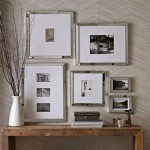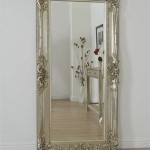```html
How To Hang A Full Length Mirror On A Door Without Nails
Hanging a full-length mirror on a door can be a practical solution for small spaces or situations where wall mounting is not feasible. The ability to check one's appearance before leaving the house is a convenience many appreciate, and a full-length mirror provides the best perspective. However, many individuals are hesitant to use nails or screws, particularly on doors that are rented or have delicate finishes. Fortunately, several methods exist to securely hang a full-length mirror on a door without causing permanent damage.
The primary goal when hanging a mirror is stability and safety. A falling mirror poses a significant hazard, so the chosen method must reliably support the mirror's weight and withstand regular door usage. Furthermore, the method should prevent scratching or marring the door's surface. This article will explore various nail-free techniques for achieving this, focusing on strength, ease of installation, and aesthetic considerations.
Choosing the Right Mirror
Before exploring hanging methods, it's essential to consider the mirror itself. The weight of the mirror will significantly influence the choice of hanging hardware. Lighter mirrors, typically those with thinner glass and less substantial frames, are easier to manage and require less robust support. Heavier mirrors, conversely, will demand stronger adhesive or brackets. Always check the mirror's specifications for its weight before purchasing any hanging materials.
The frame of the mirror also plays a role. A mirror with a solid, well-defined frame provides more surface area for adhesives or brackets to grip. Frameless mirrors can be more challenging, potentially requiring specialized mounting clips designed specifically for glass. The frame’s material – wood, metal, or plastic – will also affect the type of adhesive that will work best. For example, some adhesives may not bond well with specific types of plastic.
Finally, consider the overall dimensions of the mirror relative to the door's size. A mirror that is excessively wide or tall for the door can look disproportionate and may be more prone to accidental bumps or dislodging. Aim for a mirror that fits comfortably within the door's dimensions, leaving some space around the edges.
Adhesive Strips and Pads
Adhesive strips and pads, specifically those designed for hanging pictures and mirrors, are a popular nail-free option. These products typically feature a strong adhesive on both sides, allowing them to bond to both the mirror and the door. When selecting adhesive strips, carefully review the packaging to ensure they are rated for the mirror's weight. It is always advisable to overestimate the weight rather than underestimate it, using more strips than strictly necessary for added security.
The application process is crucial for the effectiveness of adhesive strips. First, thoroughly clean both the mirror frame and the door surface with rubbing alcohol to remove any dirt, dust, or grease. This ensures a strong bond. Allow both surfaces to dry completely before applying the strips. Follow the manufacturer's instructions for placement, typically involving pressing the strips firmly onto the mirror frame and then onto the door, holding for the recommended duration. It is important to distribute the strips evenly across the back of the mirror to distribute the weight. Avoid placing the strips near the edges of the mirror, where they are more likely to peel off.
While adhesive strips offer a convenient solution, their long-term reliability can vary depending on factors such as humidity, temperature, and the surface material of the door. Regularly inspect the strips for any signs of loosening and consider replacing them periodically to maintain optimal adhesion.
Over-the-Door Hooks and Brackets
Over-the-door hooks and brackets provide a more mechanical and potentially more secure alternative to adhesive methods. These typically consist of metal or plastic hooks that hang over the top edge of the door, with brackets or clips that attach to the back of the mirror. This method distributes the weight of the mirror across the door's frame, rather than relying solely on adhesive.
When choosing over-the-door hooks, ensure they are compatible with the door's thickness. Hooks that are too wide will fit loosely and may cause the mirror to wobble or swing. Hooks that are too narrow will not fit at all. Many adjustable over-the-door hooks are available, allowing for a customized fit.
The brackets or clips that attach to the mirror can be secured using various methods, including adhesive pads or screws. If using screws, ensure they are short enough to avoid penetrating through the mirror frame. Adhesive pads used in conjunction with over-the-door hooks can provide an extra layer of stability and prevent the mirror from rattling against the door. Again, make sure the adhesive pads are rated for the weight of the mirror. Some over-the-door hook systems come with pre-installed felt pads to protect the door's surface from scratches.
One advantage of over-the-door hooks is their relative ease of removal and repositioning. This makes them a good option for renters or individuals who may want to move the mirror to a different location in the future. However, it is crucial to ensure that the hooks are securely attached to the mirror to prevent accidental dislodging.
Leaning Mirror with Anti-Slip Protection
While not strictly "hanging," leaning a full-length mirror against a door offers a damage-free and stylish option. The key to safely leaning a mirror is to ensure it is stable and cannot easily tip over. This requires careful placement and the use of anti-slip materials.
When leaning a mirror, choose a location where it is unlikely to be bumped or knocked over. Ideally, position it against a wall that is adjacent to the door. The angle at which the mirror leans is also important. A shallow angle is generally safer than a steep angle, as it reduces the risk of tipping. However, a shallow angle may also require more floor space.
To prevent the mirror from slipping, use rubber or felt pads on the bottom edge that rests against the floor. These pads provide friction and prevent the mirror from sliding. You can also use similar pads between the top of the mirror and the door to protect the door's surface and further stabilize the mirror. Consider using furniture straps to secure the top of the mirror to a wall or the door for added security. These straps are designed to prevent furniture from tipping over and can be easily attached without causing damage.
Although leaning a mirror is a simple method, it's crucial to continuously assess its stability, especially in households with children or pets. Additionally, this method is best suited for lighter mirrors. Heavier mirrors pose a greater tipping hazard, making the other methods described above more suitable.
Regardless of the method chosen, prioritize safety and stability. Regularly inspect the mirror and its hanging hardware for any signs of wear or loosening. Taking proactive steps to ensure a secure and damage-free installation will provide both peace of mind and a functional addition to the living space.
Choosing the right method depends on the mirrors weight, the materials your door is made of and the amount of traffic that passes through the door. With careful planning and the right tools, you can successfully hang a full-length mirror without ever reaching for a hammer or nail.
```
Over The Door Hanging Mirrors A Comprehensive Guide

3 Ways To Hang A Door Mirror Wikihow

Over The Door Hanging Mirrors A Comprehensive Guide

3 Ways To Hang A Door Mirror Wikihow

Over The Door Hanging Mirrors A Comprehensive Guide

3 Ways To Hang A Door Mirror Wikihow

Diy Full Length Mirror With Storage Addicted 2

Gymax Full Length Over The Door Mirror Hanging Hooks Wall Mount Dressing Black Com

13 5 X 49 Framed Door Mirror Room Essentials Target

How To Hang A Hanging Mirror Without Accompanying Hardware








